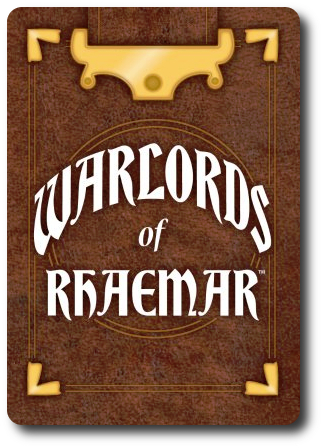
The Basics:
- For ages 6 and up (publisher suggests 12+)
- For 2 to 4 players
- Approximately 20 minutes to complete
Geek Skills:
- Active Listening & Communication
- Counting & Math
- Logical & Critical Decision Making
- Reading
- Strategy & Tactics
- Cooperative & Team Play
- Hand/Resource Management
Learning Curve:
- Child – Easy
- Adult – Easy
Theme & Narrative:
- Challenge the greatest warlords in the kingdom!
Endorsements:
- Gamer Geek rejected!
- Parent Geek mixed!
- Child Geek approved!
Overview
A summons was sent to every corner of the kingdom. The recipients of the note were only provided a time and a place with a simple question put to them. “Are you the greatest warlord in the land?” Many traveled great distances out of curiosity and to prove that they were. Now, at the appointed place and at the appointed hour, the greatest warlords of the Kingdom of Rhaemar will challenge each other, achieving victory or suffering death!
Warlords of Rhaemar, designed by Kenneth Robinson and published through the Game Crafter, is comprised of 20 Warlord cards, 12 Weapon cards, 12 Curse cards, 12 Armor cards, 12 Enchantment cards, and 4 Declaration cards. All the cards are durable and as thick as your standard playing card. The illustrations by Lauren Chaikin capture the uniqueness of each of the warlords and their possible equipment. Not included with the game, but necessary to play, is a pen or pencil and piece of paper to keep track of players’ Victory points.
Game Set Up
To play the game, first separate the cards by type, organizing the types into piles, face-down. When you are done, you should have a Warlord, Weapon. Curse, Armor, and Enchantment pile. Shuffle each pile separately. These will be the individual draw piles for the duration of the game. Leave room next to each draw pile for a discard pile.
Second, pick up the Warlord draw pile and deal each player 5 Warlords. Players should keep their Warlord cards hidden from their opponents until played. When done, place any remaining Warlord cards back in the game box.
Third, determine who the first player will be. The first player now draws 1 Weapon, 1 Curse, 1 Armor, and 1 Enchantment card. Then the first player can select 2 more cards from the Weapon, Curse, Armor, and Enchantment draw piles; however, the first player can only draw 1 additional card from the draw piles, not 2 from the same. For example, the first player could draw 1 Armor and 1 Weapon card, but could not draw 2 Armor or 2 Weapon cards. These cards are added to the player’s hand. When the first player is done, the next player in turn order sequence now repeats the same step and so on until all players have a total of 6 cards.
Fourth, give each player 1 Declaration card and begin!
The Cards of Rhaemar
There are five different types of cards in the game. Each are summarized here.
The Warlords
The Warlord cards represent the 20 different combatants who stand ready to do battle. Each warlord has a brief backstory in the rules, if players want to learn more about who they are fighting. What players will really want to pay attention to, however, is the Warlord card. Each Warlord card has a reserved spot for 1 Weapon (W), 1 Armor (A), 1 Curse (C), and 1 Enchantment (E) card. These cards are placed next to the Warlord card to signify they are equipped. Each Warlord card will also list the warlord’s default Power rating (P) and Victory rating (V). Some warlords will also have special abilities and restrictions. Players will need to play to each individual Warlord’s strengths and weaknesses if they are to achieve victory.
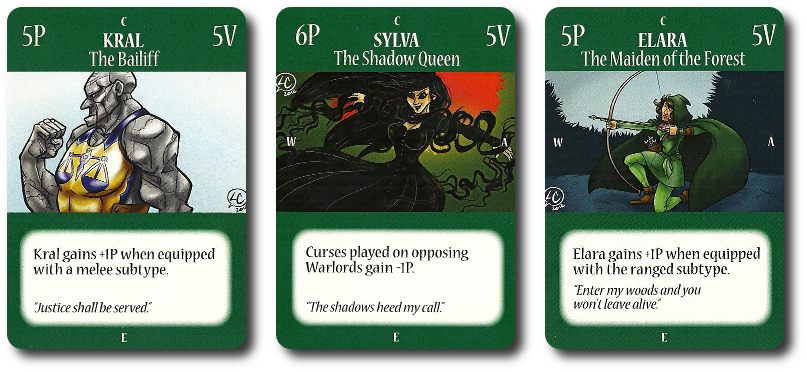
Weapons
The Weapon cards represent the various sharp and deadly pieces of equipment the warlord can pick up and use to kick their enemy’s butts. There are three subtypes of Weapon cards. These are Melee Weapon cards , Ranged Weapon cards, and Shield Weapon cards. Only 1 Weapon card can be equipped by a warlord. Depending on the Weapon card used, the warlord’s Power and Victory rating will increase or decrease. The Weapon card might also provide an additional ability or bonus.
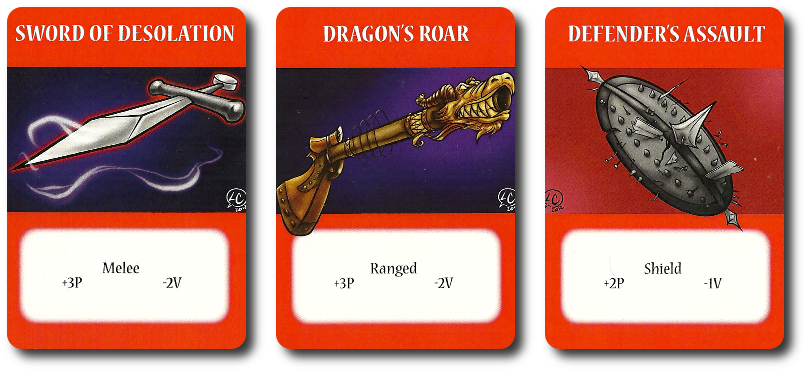
Armor
The Armor cards represent the various pieces of leather, metal, and other materials that warlords wear to help protect against damage. Like the Weapon cards, there are three subtypes of Armor cards. These are Light Armor cards, Medium Armor cards, and Heavy Armor cards. Armor cards will also provide a modifier to the warlord’s Power and Victory rating, as well as possibly providing an additional ability or bonus. Armor can also block which cancels damage being inflicted by other Warlords.
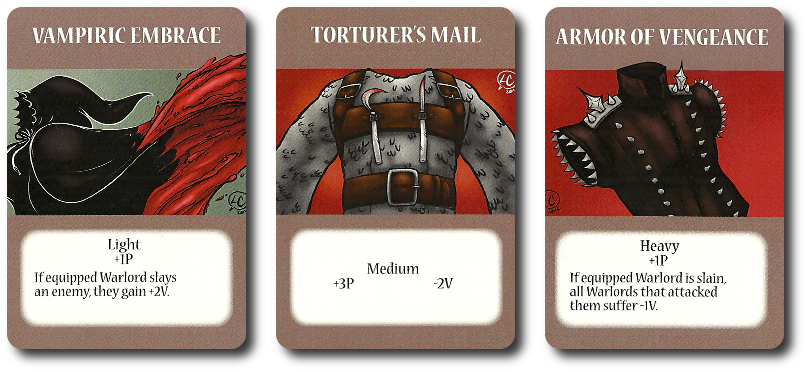
Enchantments and Curses
The Enchantment and Curse cards represent magical items and supernatural powers. Enchantments are beneficial to the warlord who equips them and curses tend to be detrimental to a warlord’s health. But not always. A player might find a creative way to use an enchantment to hamper a warlord or utilize a curse to boost their warlord to victory. It’s all in the way the player decides to use the cards. There are three subtypes of Enchantments and Curses. These are Spells, Potions, and Trinkets.
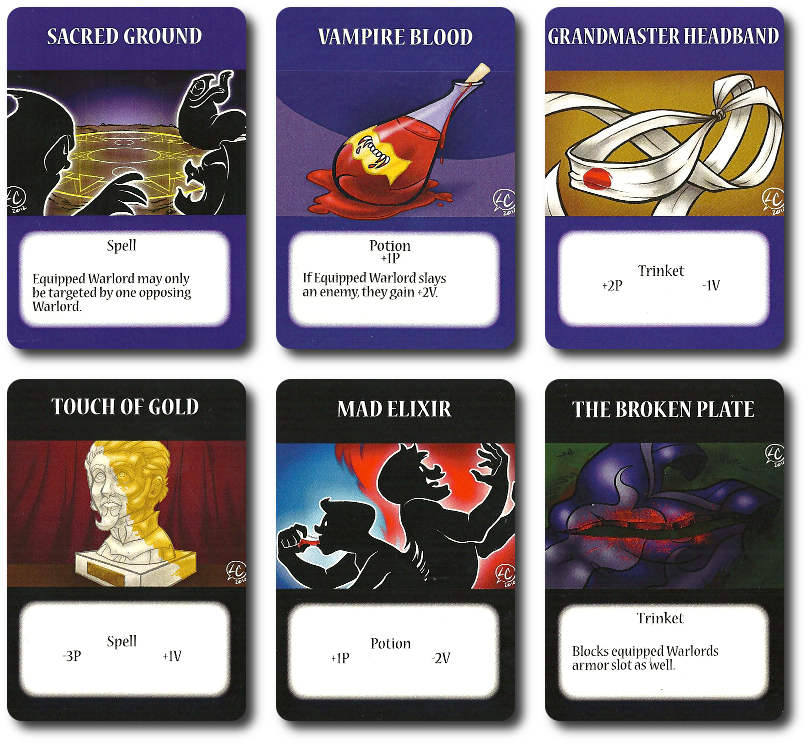
Modes of Play
Warlords of Rhaemar can be played 3 different way. Both game modes use the same rules, but play slightly differently when it comes to player interaction.
Free for All
This game mode pits every player against each other. Anything goes, but alliances can be made if the players want. But teams must eventually be disbanded because only 1 player can win in the end.
Team Play
If playing with 4 players, create 2 teams of 2. Have each team member sit across from their fellow teammate. Table talk should be kept to a minimum between team members, but it’s allowed. Specifics like what cards are going to be played and what cards are held in a player’s hand cannot be shared, for example. Players will earn their own Victory points, but they will add them together as a team at the end of the game.
Tournament Play
Using either Free for All or Team Play game modes, Warlord cards are drafted during game set up. Place all the Warlord cards on the table, face-up. Players then take turns picking up 1 Warlord card at a time until they have 5. The same can be done with Armor, Enchantment, Curse, and Weapon cards if the players like.
Honorable Combat
Warlords of Rhaemar is played in rounds for a total of 4 rounds in a single game (3 rounds if playing with 3 players using the Free for All game mode). Each round is divided into 5 phases where players take turns. A typical game round is summarized here.
Phase 1: Assign Your Warlord
Starting with the first player and continuing in turn order sequence, each player selects 1 Warlord card and places it face-up in front of them.
Phase 2: Equip
Starting with the first player and continuing in turn order sequence, each player selects 1 Weapon, 1 Armor, 1 Enchantment, or 1 Curse card to play to ANY Warlord card. Not just the player’s Warlord. When the turn order ends with the final player (not the first player), the final player then plays their second Weapon, Armor, Enchantment, or Curse cards. The turn order sequence now reverses and the remaining players place their second card.
A player can also elect to skip one or both of their opportunities to play a Weapon, Armor, Curse, or Enchantment card during this phase. If they do, they may either discard a Weapon, Armor, Curse, or Enchantment card of their choice and draw any other card to replace it (other than a Warlord) or give their Warlord card in play a temporary +1 Power or +1 Victory boost for the round (not both). Nothing is provided in the game to help players keep track of this bonus. We used small stones which worked just fine.
Phase 3: Declaration of War
Each player now takes their Declaration card and determines if they will be defending or attacking. If the player decides to attack, they must determine if they will attack the opponent to their left, right, or directly in front of them. The choice to defend or attack is done in secret and the player’s selected action should be at the top of their Declaration card (closest to the middle of the playing area) when placed face-down.
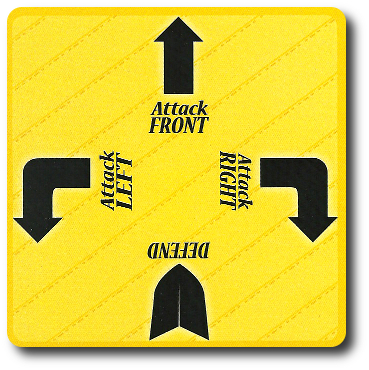
Optionally, players can simultaneously or in turn order sequence announce who they are attacking or if they are defending. The preferred method by all our groups was using the Declaration cards. Taylor this phase of the game to your group’s preferences.
After all the players have placed their Declaration cards, they are simultaneously revealed. Players who are defending announce their Warlord’s Power rating for the round. Players who are attacking announce who they are attacking and their Warlord’s Power rating for the round.
Phase 4: Resolution
All combat in the round happens at once. Turn order is not used. However, it’s worthwhile going around the table to determine how many players are attacking an opponent.
Note: A player can be attacked by multiple players, but they are only ever attacked once. All attacks happen at the same time. This means it’s possible for the player to attack and be attacked at the very same moment. Possibly even being double-crossed by a supposed ally!
Attacking
Attacking warlords compare their Power rating to their target’s Power rating. If more than one warlord is attacking the same target, the combined Power rating of the attacking warlords are calculated. The attacking warlord or warlords win if the total Power rating of the attack is HIGHER than the target’s Power rating. If the total is EQUAL TO or LESS, the attack fails.
Defending
Defending warlords can shift their Power and Victory ratings around using a 1:1 ratio. For example, for 1 Victory, the player can increase their Power rating by +1.
After all the attacks have been resolved, warlords who were defeated and any cards attached to them are now discarded to the correct discard piles. Warlords who survived and any cards attached to them are returned to the player’s hand. This includes Curses. Now you can get back at the player who cursed you!
Victory points are now scored, as well. Victory points are only awarded to those players whose warlords survived. Players do not get points for defeating a warlord or if their warlord was defeated. Each player should keep track of their own points or assign 1 player to keep track of them.
Phase 5: Preparation for the Next Round
The first player is now passed to the next player in the turn order sequence. Starting with the first player, each player will draw any number of Weapon, Armor, Enchantment, and Curse cards until their total hand (minus the Warlords) is 6 cards. When drawing, any cards can be taken if there are cards in the draw pile to be had. Cards in the discard pile never come back into play. Additionally, a player cannot take any more than 1 card per draw pile. As the game progresses, a player might not be able to draw enough cards to bring them back up to a total of 6 cards.
This ends the round. A new round now begins starting with phase 1 noted above.
Ending the Game
The game ends after phase 5 of the 4th round (or 3rd if playing a 3-player gamer).
- If playing Free for All, the player with the most Victory points wins the game.
- If playing Team Play, the team with the most combined Victory points wins the game.
To learn more about Warlords of Rhaemar, visit the game’s web page.
Final Word
The Child Geeks had a great time with Warlords of Rhaemar. One Child Geek said, “This game reminds me of Mortal Kombat, only it’s a fantasy world.” One aspect of the game play that frustrated the Child Geeks at first was the inability to fully equip their Warlord cards. As one Child Geek put it, “Why would I go into combat without a sword, shield, and a magical spell?” But this limitation is part of the challenge and the Child Geeks soon accepted it. We observed some interesting choices that were borderline reckless gambles to applaudable tactical plays. When all the games were over, the Child Geeks had no problem endorsing Warlords of Rhaemar. To quote one Child Geek after a game was over, “This is the best fight I’ve been in all day.”
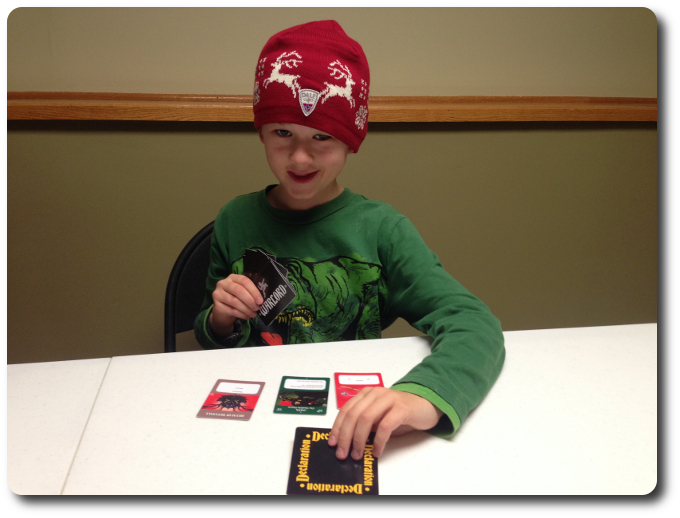
Note to Self: If you are the only adult at the table when playing, you will be attacked EACH AND EVERY TIME
The Parent Geeks were less impressed with Warlords of Rhaemar, but found it to be an entertaining game to play with their family. This was especially true when playing in teams. According to one Parent Geek, “I found the everyone versus everyone game mode to be filled with too much guessing. When you play as a team, you can be much more tactical and strategize with the other player. That’s pretty entertaining.” Another Parent Geek said, “After playing this game a few times, I want to see more and different cards. Especially cards that have more abilities, effects, and limitations.” As it turns out, the Parent Geeks wanted the game to challenge them more in the specific area of hand management. Many of the Parent Geeks felt like the choices were too easy to make. As one Parent Geek put it, “If you make the game easy to play, that’s great. But if the game doesn’t challenge you, that’s bad.” The voting results showed that Warlords of Rhaemar was neither loved or disliked by the Parent Geeks.
The Gamer Geeks liked the concept, but felt the game failed to achieve its goal. According to one Gamer Geek, “It’s always a good idea to spend all your time focusing on Power and then smacking down another opponent. The only variable is the cards in your hand.” Another Gamer Geek said, “I think this game is fine as it is, but it’s not nearly tactical or strategic enough for me to want to play it again.” Descriptions like “too light” and “no depth” were used to describe the game, but all the Gamer Geeks believed that Warlords of Rhaemar had potential. As one Gamer Geek put it, “This is a game that has promise, but it needs a lot more work, depth, and challenge before it’s even close to being as epic as it wants to be.” The Gamer Geeks voted to rejected the game.
I am surprised that more of our players didn’t enjoy the game. I saw Warlords of Rhaemar as a light card drafting game with some interesting hand management thrown in. If you focus on the Warlord card, you can focus on collecting the correct equipment to dominate the battles. Where it becomes complicated is the lack of time to build, deploy, and destroy. This unnecessarily forces a player to take shortcuts and rush, which is why I think many of our players just saw Warlords of Rhaemar as a fantasy battle card game instead of something more.
Another aspect of the game that I enjoyed is only apparent when playing in teams. Teammates can devise some killer warlords and sacrifice a weaker warlord to obtain a lot of Victory points in the game. It’s a gutsy move, but one worth attempting. It can spectacularly succeed or fail, which is part of the fun.
I enjoyed the game with my little geeks, but never with Parent and Gamer Geeks. As many have already said, it’s just not an interesting enough game to keep the more experienced and hardcore gamers fully engaged. Casual gamers enjoyed it, but not enough to play it again. The Child Geeks’ excitement for the game kept the game play fun. It’s hard not to get excited when everyone else at the table is wearing evil grins and bouncing in their seats in anticipation of the battle to come.
If you are looking for a light fantasy-based card game where there are choices to be made, but never to a point where the choices are overly difficult, then do sit down and play Warlords of Rhaemar.
This game was given to Father Geek as a review copy. Father Geek was not paid, bribed, wined, dined, or threatened in vain hopes of influencing this review. Such is the statuesque and legendary integrity of Father Geek.



